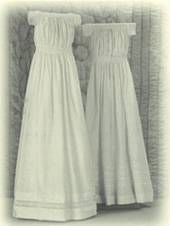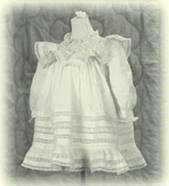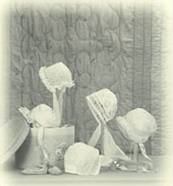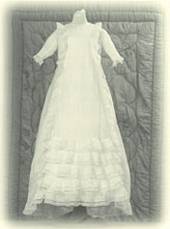Dream Stitches: Baby’s Layette
Introduction
She never cared for sewing, but it's different now, you know,
For she sits each day and stitches, and her eyes are all aglow,
As she handles each wee garment, and her glad heart sweetly sings
With a mother's love and longing as she makes those tiny things -
I am stitching dreams my baby, many a dream and many a prayer
Will be sewn into the garments that my liltle
one will wear,
And I think, perhaps, they'll whisper very soft to you, my dear
Of the love Owl has been waiting just to make you welcome here!" (1)
At the turn of the twentieth century, most women knew how to sew and the sewing machine was common in many homes. However, the belief that a layette or a baby's "first clothes" should still be made by hand was widely accepted. Mothers-to-be were advised to use only the best quality materials in making a layette. Dr. Ellen Dean Wade stated in the Twentieth Century Baby that:
The material for the baby's first clothes should be as fine and soft as one's means
will allow .... Everything for the baby must be of the best quality obtainable. (2)
A layette consisted not only of garments but also included bedding and toilet articles
for a newborn child. According to an article in the 1917 American Dreddmaking Step
by Step, the following items were considered a necessary part of a basic
layette: (3)
- 4 Dresses
- 3 Petticoats (flannel)
- 2 Sacks
- 3 Pairs Booties
- 1 Diaper Cover
- 1 Coat
- 2 Shawls
- 6 Dayslips
- 3 Petticoats (white)
- 3 Flannel Bands
- 3 Pairs Stockings
- 4 Dozen Diapers
- 2 Bonnets
- 1 Carriage-robe
- 6 Nightslips
- 2 Kimonos
- 3 Shirts
- 4 Pinning Blankets
- 6 Bibs
- 1 Veil
- 1 Receiving Blanketquiltmaking, to plantation life.
Long Gowns
 This exhibition featured examples of long infant gown styles that were widely used
during the nineteenth century (Figure 1). This changed as the focus turned more to
the comfort of the infant and gown lengths gradually became shorter. By 1889, the
Wife and Mother book stated:
This exhibition featured examples of long infant gown styles that were widely used
during the nineteenth century (Figure 1). This changed as the focus turned more to
the comfort of the infant and gown lengths gradually became shorter. By 1889, the
Wife and Mother book stated:
How absurd, too, the practice of making them wear long clothes. Clothes to cover a
child's feet, and even a little beyond, may be desirable; but for clothes, when the
infant is carried about, to reach to the ground, is foolish and cruel in the extreme
(4).
This author goes on to advocate that gowns should only be 30 inches to a yard in length.
By 1920, the recommended length had been reduced to 28 inches or less.
As the baby grew and became more active, gowns were shortened to a more manageable length. Guidelines were given for the right time for "shortening the babe" depending on the season and age of the child. Although not all authorities agreed on this subject, the standard age was usually between two and six months.
Short Dresses
 The first clothes for babies of the late nineteenth and early twentieth centuries
were predominately white in color and were made without regard to the gender of the
infant. Both male and female babies were dressed in frills (Figure 2). However, a
touch of color was sometimes used to personalize the clothing. According to a 1914
article in The Sunday SentineL:
The first clothes for babies of the late nineteenth and early twentieth centuries
were predominately white in color and were made without regard to the gender of the
infant. Both male and female babies were dressed in frills (Figure 2). However, a
touch of color was sometimes used to personalize the clothing. According to a 1914
article in The Sunday SentineL:
If you like the color note on the little one's garments, use pink for the boy and
blue for the girl, if you are a follower of convention (5).
This practice is just the opposite of today's tradition of pink for a girl and blue
for a boy. The Art of Dressmaking, published by Butterick in 1927, reiterates this
use of color:
All baby clothes should be white, and as fine and dainty as possible. Pale shades of baby pink and blue can be used for ribbons on dresses and caps ... [and] for baby kimonos, sacks, sweaters and booties ... etc. But the actual dresses, slips, caps and coats, petticoats, etc. are always white (6).
Accessories
 To be properly dressed for out of doors, the baby must, of course, have one or more
bonnets. As the strings required for a baby's bonnet always become soiled more quickly
than the bonnet itself, strings of batiste or lawn are more satisfactory than those
of ribbon. For convenience, therefore, several pairs of strings should be provided,
and instead of sewing them to the bonnet they may be pinned in place with attractive
baby pins, so that they may be easily changed (7).
To be properly dressed for out of doors, the baby must, of course, have one or more
bonnets. As the strings required for a baby's bonnet always become soiled more quickly
than the bonnet itself, strings of batiste or lawn are more satisfactory than those
of ribbon. For convenience, therefore, several pairs of strings should be provided,
and instead of sewing them to the bonnet they may be pinned in place with attractive
baby pins, so that they may be easily changed (7).
Christening Gowns
 Babies were christened either in the church or at home, generally in the presence
of relatives and close friends. The elaborateness of the infant's gown varied with
the formality of the ceremony. If the christening took place in the church, the baby
was often dressed in an exquisite gown (Figure 4). According to The New Book of Etiquette:
Babies were christened either in the church or at home, generally in the presence
of relatives and close friends. The elaborateness of the infant's gown varied with
the formality of the ceremony. If the christening took place in the church, the baby
was often dressed in an exquisite gown (Figure 4). According to The New Book of Etiquette:
On this first important appearance in church, baby wears an elaborate christening
dress - possibly the very dress worn by its mother, father, or grandparent. (8)
A home christening was sometimes recommended as being more desirable for both mother
and baby.
If baby is given its name at home, there is no tiresome journey to and from the church, no dressing and re-dressing to try the patience of the most good-natured little newcomer. (9)
References
(1) Aunt Kate's Day-By-Day Book (N.p.: John Leng & Co. Ltd, 1937) 296.
(2) Ellen Dean Wade, Twentieth Century Baby (N.p: n.p., n.d.) 4. (Publisher not stated, copy on fuel.
(3) Lydia Trattles Ceates, American Dressmaking Step by Step (New York: The Pictorial Review Ce., 1917) 194.
(4) Pye Henry Chavasse, M.D., Wife and Mother; Information for Every Woman (Philadelphia: H.J. Smith and Company, 1989) N.pag.
(5) The Sundayy Selltinel 29 Mar. 1914: N. page. (Publisher unknown, copy on file).
(6) Art of Dressmaking (N.p.: Butterick Publishing Co., 1927) 229.
(7) Woman's Institute of Domestic Arts and Sciences (Great Britain: International Educational Publishing Co., 1917) N. pag.
(8) Lillian Eichler, The New Book of Etiquette (Garden City, New York: Garden City Publishing Company, Inc., 1934) 250.
(9) Eichler 250.
Garment photographs courtesy of Murray Riss, as seen in Creative Needle Ma.qazine, Vol. 13, No. 1, Jan/Feb 1997.
Credits
This virtual scarpbook was made with information taken from the publication that was issued in conjunction with the exhibition "Dream Stitches: Baby's Layette," held at the LSU Textile and Costume Gallery from January through December 1997.
Jeannie Downs Baumeister, Guest Curator
Jenna Tedrick Kuttruff, Co-Curator
Pamela Pace Rabalais, Co-Curator
The following were acknowledged for their contribution to the exhibition:
- The Fashion Group Foundation of New Orleans, Inc.
- Friends of LSU Textile and Costume Gallery
- Creative Needle Magazine
- The Old Fashioned Baby
- Lagniappe Antiques
This virtual scrapbook was compiled for TCM by Dr. Santaella